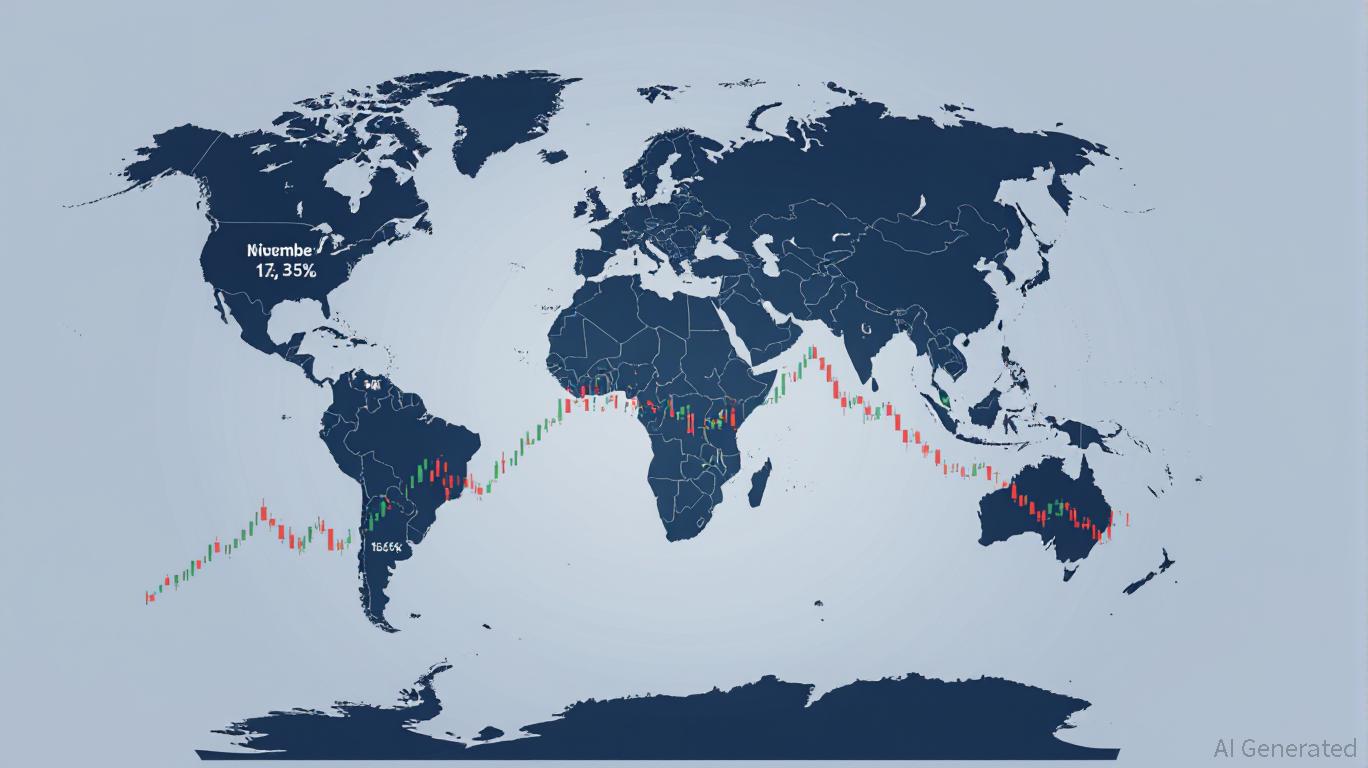The Driving Force Behind Bitcoin’s Latest Steep Drop: Macro-Economic Uncertainty Versus Investor Mood in Cryptocurrency Price Fluctuations
- Bitcoin's November 2025 plunge below $100,000 triggered $869M in U.S. ETF outflows, the second-largest single-day withdrawal. - Macroeconomic risks, including U.S. inflation and UK fiscal shifts, heightened global uncertainty, undermining Bitcoin's perceived safe-haven status. - ETF outflows and fragile retail investor confidence accelerated the selloff, with BlackRock’s IBIT and Fidelity’s FBTC losing $256M and $120M respectively. - The interplay of macro risks and market sentiment created a "perfect st
When Bitcoin dropped below $100,000 in November 2025, it signaled a major turning point for the cryptocurrency sector,
Macroeconomic Factors: Inflation, Fiscal Policy, and Central Bank Guidance
The selloff in November 2025 happened alongside persistent inflation worries in the U.S. and an unexpected fiscal shift in the UK. Even after a 43-day U.S. government shutdown ended,
Although Bitcoin is often seen as a safeguard against economic instability, it appeared exposed to these developments. Anticipated changes in interest rates—especially in the U.S. and UK—created ambiguity around future borrowing costs, dampening appetite for riskier assets. As one market expert put it, "Bitcoin’s reputation as a safe haven diminishes when investors focus on liquidity and fiscal reliability rather than speculative investments"
Investor Sentiment: ETF Movements and Trading Behavior
While broader economic risks set the context, shifts in investor sentiment—reflected in ETF flows and institutional actions—served as the immediate trigger for Bitcoin’s slide. On November 13, 2025, spot Bitcoin ETFs
The downturn was made worse by shaky investor confidence. Although the U.S. government shutdown was over,
Retail trading patterns further highlighted the market’s vulnerability. The Canary XRP ETF (XRPC)
Comparative Perspective: Macroeconomic Risks Versus Market Mood
The relationship between macroeconomic threats and investor sentiment paints a complex picture. While inflation and fiscal unpredictability fostered a risk-averse climate, the rapid and deep decline in Bitcoin’s value was intensified by feedback loops in investor actions. For instance,
Although academic research is limited in the cited sources, market data allows for some conclusions. The HBAR example demonstrates that while ETF inflows can temporarily absorb selling, they are insufficient to reverse larger trends when macroeconomic forces are dominant
Future Outlook: Navigating Macro and Sentiment Drivers
The events of November 2025 highlight the need to pay close attention to both economic fundamentals and investor psychology. While institutional withdrawals and retail attitudes directly influenced the selloff, the underlying environment—characterized by inflation uncertainty and fiscal experimentation—set the stage for increased volatility.
For those investing in crypto, the takeaway is straightforward: Spreading risk and using hedges against macroeconomic shocks (such as inflation-protected assets or diversified ETFs) may be essential for weathering future downturns. At the same time, the endurance of new crypto offerings like the XRPC ETF indicates that innovation could help counterbalance short-term market swings.

Disclaimer: The content of this article solely reflects the author's opinion and does not represent the platform in any capacity. This article is not intended to serve as a reference for making investment decisions.
You may also like
The Momentum ETF (MMT) Rally: Institutional Accumulation and the Mindset Behind Small-Cap Expansion in 2025
- Momentum ETF (MMT) surged 1330% in Q3 2025 due to $10M institutional investments from Coinbase Ventures, OKX, and Jump Crypto. - Market psychology shifts toward small-cap growth as Hartford Funds forecasts 2025 small-cap earnings to outpace large-cap peers amid macroeconomic uncertainty. - MMT's $12B DEX volume and $265M TVL highlight liquidity-driven speculation, but analysts warn long-term success depends on proving real-world utility beyond short-term inflows. - Mercurity Fintech's inclusion in MSCI S

Bitcoin News Update: DeFi Faces Liquidity Challenges Amid Bitcoin Falling Under $100K
- Bitcoin's drop below $100K triggered DeFi liquidity crises, with $650M in leveraged positions liquidated as automated stop-losses activated. - Wrapped Bitcoin (WBTC) integrated with Hedera blockchain to reduce MEV and frontrunning, aiming to inject liquidity into DeFi protocols. - Hyperion DeFi reported 60% MoM validator growth and new partnerships, emphasizing staking yields over leveraged positions to avoid market volatility. - Analysts like Tom Lee predict 6-8 weeks for recovery, contingent on stabili

Assessing How Recent Ecosystem Enhancements Influence Trust Wallet Token (TWT) Price Forecasts
- Trust Wallet's Q4 2025 upgrades expanded TWT's utility through FlexGas (gas fee payments) and Trust Premium loyalty incentives, transforming it from governance to transactional token. - TWT surged 129% to $1.6 by October 2025, fueled by Binance CZ's endorsement and institutional validation of its ecosystem-driven value proposition. - The token's growth aligns with multi-token economy trends, emphasizing cross-utility, stability, and transparency through fixed supply models and public audits. - While regu

Astar (ASTR) Price Rally: Cross-Chain Compatibility Fuels Altcoin Value Growth
- Astar (ASTR) surged in late 2025 due to strategic blockchain interoperability advancements and partnerships. - Collaboration with HTX includes TGE Catalyst Grants, listing acceleration, and CEX partnerships to boost DeFi adoption. - Astar 2.0's zkEVM and CCIP integration achieved 150,000 TPS, targeting 300,000 TPS by 2025 with enterprise partnerships. - Interoperability-driven projects like Astar are reshaping altcoin valuations, aligning with growing institutional DeFi demand.
